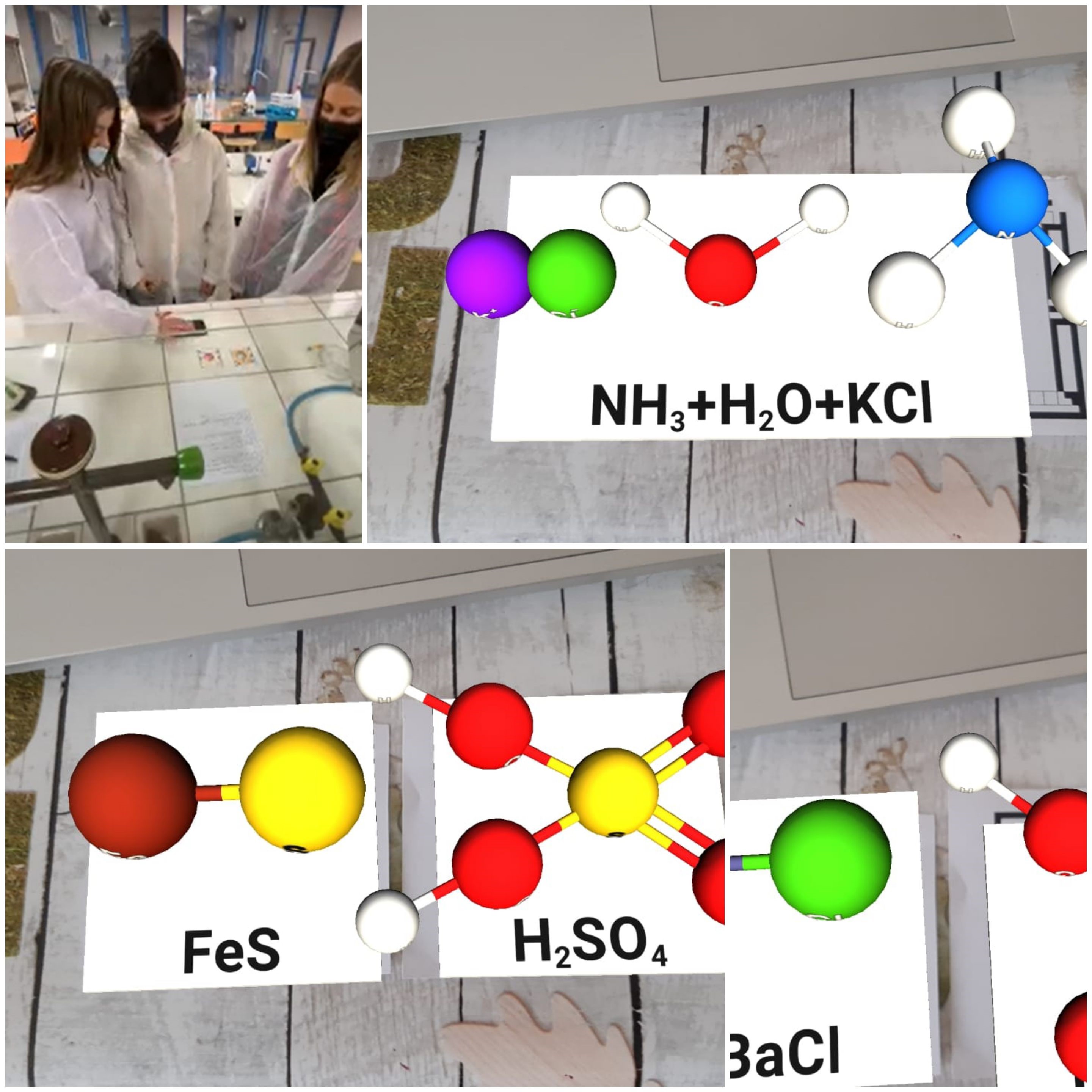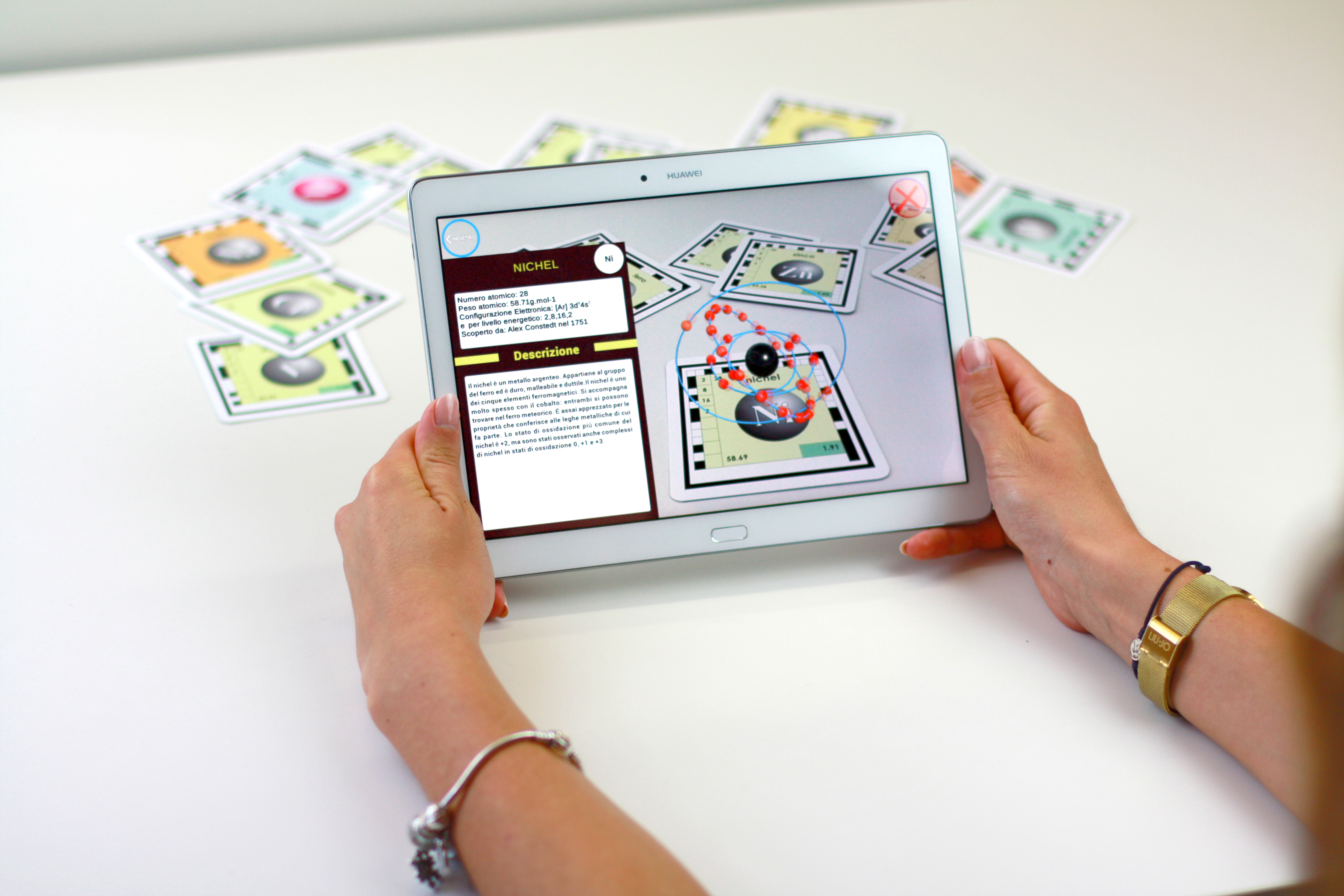Main navigation
1. Overview
Name
ARSCHIMICA_ITT_MARCO_POLODescription

Activities / Project Phases
Materials
- no filesComments
Start date
2021-11-01End date
2022-01-312. Discover
Discover the Main Topic
With the support of the Augmented Reality APP ARS CHIMICA, using cards A and B and framing them, students from the ITT Marco Polo in Florence are able to view the reagent molecules and then by combining the cards they will find the products of the reaction obtained. They can experience all the different types of chemical reactions, thus highlighting the formation and breaking of the bonds present within the compounds. Through the APP, pupils can then practice balancing chemical equations and test themselves with a verification quiz, by levels (basic, intermediate, advanced).
Short Description
Chemistry; Sciences
Discovery Activities
Ars Chimica has been used to make students investigate and understand three fundamental topics:
- the periodic table structure (Interpret and connect the structure and characteristics of the periodic table to the electronic configuration of an element. Identify the position (group or period) of an element in the periodic table. Describe the trend of the main periodic properties: the properties of the elements decrease or increase along the periods or groups on a regular basis. Identify the metal, semi-metal and non-metal elements in the periodic table)
- chemical bonds (Relate the characteristics of the bonds to the properties of the elements. Predict the type and number of bonds that can be established between atoms. Describe how electronegativity makes it possible to predict the type of bond that arises between the elements)
- chemical reactions (Identify a chemical reaction based on macroscopic clues. Represent chemical reactions by means of reaction equations. Describe the reactions of synthesis, decomposition, single-replacement and double-replacement. Balance the chemical equations. Observe and describe the development of the reactions and the products obtained )
The laboratory activities have been organized in dedicated sessions, after the school time. The students have been selected as a whole class, in order to confront a homogeneous sample. They worked in groups and compared their results.
Each of the three activities was carried out with a learning by doing approach. The App plays the role of a facilitator, since it creates images of non-visible stuff -helping the students to build virtual objects in their imagination- and shows the results of the action taken -allowing them to experiment all possible outcomes, even the dangerous ones.
3. Understand
Audience
ARS Chimica enables learners of secondary schools to gain knowledge in chemistry. Many students consider chemistry a complicate science, due to the use of notions which cannot become the objects of direct comprehension; as a result, students have to create images, virtual objects exactly in their imagination. Not all students are able to create such objects, or to create them in an appropriate correspondence to the reality. That's why teaching tools conceived to intensify visualization are always essencial in the process of chemistry teaching. This APP, based on augmented reality and game-based learning, can be useful, for example, to study non-perceptible notions (e.g. atom, molecule, chemical bonds, etc.). 3D-models and graphic interface of tools for chemistry teaching which use augmented reality might have indeed a positive influence on the upper secondary and iVET students’ level of interest in the discipline and a corresponding increase of acquiring knowledge.
Science teaching
THE PERIODIC TABLE
After the download of the Augmented Reality APP on your mobile or tablet, choose a card and frame it with your device and observe the atom configuration of the element you have chosen; on the card you will already find some parameters but you can get others from the image and the position in the periodic table. Repeat the experience with other cards and then try to sort them based on their periodic properties.
CHEMICAL BONDS
Using the ARS CHIMICA APP and some cards of assigned elements, the students, divided into groups, will have to calculate the difference in electronegativity between two elements and identify the type of bond that is formed, then figure out the compound that could be obtained.
CHEMICAL REACTIONS
In the laboratory it will be possible to observe the characteristics of a reaction and apply a chemical equation. By reproducing some situations resulting from the interaction of substances, making the children observe what happens, for example, when two materials are put into contact or when a substance is heated or, again, when it is placed in contact with a flame, it will stimulate their natural curiosity to pose questions about why and how the observed phenomena occur. Reflection on chemical reactions will provide an opportunity to analyse and to classify them into different types: synthesis, decomposition, single-replacement, double-replacement. Students will be guided to understand that chemical reactions, and the equations that represent them, must be balanced to respect the fundamental Law of conservation of mass (Lavoisier’s Law).
- With the support of the Augmented Reality APP, using cards A and B and framing them, students will be able to view the reagent molecules and then by combining the cards they will find the products of the reaction obtained.
- Pupils will be able to experiment all the different types of chemical reactions, thus highlighting the formation and breaking of the bonds present within the compounds.
- Through the APP, pupils can then practice balancing chemical equations and test themselves with a verification quiz, by levels (basic, intermediate, advanced).
Technology and Engineering
Artistic matters
Mathematics in Teaching
Discussion about topics
Target Group Research
The students didn't do a big research. This was more a development case.
4. Design
Design of the Solution

-
- no files
5. Prototype
Augmented Reality Prototype

Cross media model
6. Test
Questionnaire
-
- no files
Review of test results
The APP is easily transferable to non-formal context, especially considering that it is already ‘equipped’ with game-based learning activities. Regardless of the context, it's a useful tool to strengthen soft skills like problem solving, information use and self-awareness.
Ars Chimica is a very user-friendly tool, there were no problems in its presentation nor in the use by the students. On the contrary, giving an easy approach to a difficult subject helps the students to stay focused on the concepts, while the gaming side helps in stimulating their curiosity and catching their attention. Once discovered that chemistry - and more generally STEM subjects - is less unreachable than expected, more young people will take into consideration STEM careers.
7. Share
App Description
ARS Chimica is a kit consisting of 120 cards to learn chemistry in an interactive and super engaging way. The matching app, compatible with Android and iOS devices, allows you to activate three-dimensional content and additional information, simply by framing the cards inside the package.
Specifically:
118 cards illustrate the elements of the periodic table
2 cards A and B are used to generate chemical reactions.
Visualizing the structure of the atom, the types of bonds or generating a chemical reaction becomes an exciting experience with ARS Chemistry.
Use it at school for an interactive and engaging lesson, or at home to review notions already explained by teachers and test yourself with numerous exercises.
The app, after being activated, can also be used in offline mode.
For a truly immersive and experiential lesson, it is also possible to project the content on a lem/interactive display to immerse students in environments perceived as real and richer in information content. The classroom is thus transformed into a real three-dimensional chemistry laboratory where digital and reality blend perfectly.
A product, the result of Research and Development of an Italian software house in collaboration with a team of teachers, which combines technological innovation made in Italy and tradition (paper, much appreciated by teachers and experts in the field) and that focuses on ease of use.
Technology, augmented reality in this case, is not an end but a means, to create immersive and truly amazing educational experiences.
Offline sharing
-
- no files